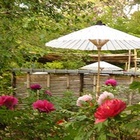On her 27th birthday, Hana got married to her husband, Eiji, who was three years younger than her and was the younger brother of her classmate.
Six months ago, that same classmate came to visit Hana. Her younger brother was going to Japan to work, but it was decided that if he was going to work, it would be better to get married first, so he was looking for a wife. The classmate immediately remembered Hana and came to see her.
Hana, who had been heartbroken about two years ago, wasn't interested in marriage, but she decided to meet Eiji, thinking that this was an opportunity to live in Japan, which she had always dreamed of. The two then started dating, and as their planned departure date for Japan was approaching, they held their wedding a few months later.
The couple began their married life in Japan. They worked at the same factory and went out together on their days off. Eiji went fishing with his dekasegi friends, and Hana attended Japanese language classes.
Two years later, their first daughter, Lina, was born. However, during this pregnancy, Hana developed high blood pressure. Her concerned mother flew over from Brazil to help out.
His mother had planned to stay in Japan until her grandchild was about three months old, but one day Eiji suddenly quit his job.
Though he appeared healthy, Eiji was mentally exhausted. He was diagnosed with stress syndrome. He was told that he could not continue working at the factory and asked to go back to Brazil.
Hana was so shocked that she became bedridden. She asked her husband to let her receive treatment in Japan, but Eiji did not listen to her and returned to Japan alone.
Hana decided to stay in Japan, and her health gradually improved. With her mother's help with the housework and taking care of her children, she returned to work.
After returning to Brazil, Eiji called Hana twice. In the first call, he said, "It takes time to treat stress syndrome, so it can't be helped. I really want to go back to Japan soon. I want to see Hana and Lea..." In the second call, he said in a cheerful voice that he had found a job, but he never contacted me again.
Soon after, Hana's younger brother, who graduated from a university in Brazil and got a job at a Japanese company, came to Japan. Her mother returned to Brazil and divorced her husband, who was a company employee, and the two of them came to Japan to work. Thus, Hana's family gathered in Japan, and Lina grew up under the watchful eye of everyone in her family.
After graduating from junior high school, Lina visited Brazil for the first time with her mother. She found Sao Paulo in December to be a very difficult city to live in, as it was hot and stuffy.
"Where in Sao Paulo is my father?" Lina wondered.
When we lived in Japan, my husband, Eiji, would often say, "I'd like to go to Plaza de la Repubblica again. When I was a student, I used to paint oil paintings and sell them there. People said that I was a good artist."
Remembering this, Hana wanted to go to Plaza de la República in the center of the city. Hana had always lived in São Paulo before going to Japan, but she had never been there. On Sunday morning, Hana and her friends visited the flea market in Plaza de la República. It was a very lively open-air market with tents selling typical Brazilian souvenirs, handicrafts, accessories, and more.
Hana picked up a pendant and bracelet made of Brazilian semi-precious stones and asked, "Lina, which one do you want?" When she turned around, Lina was not beside her. In a panic, she put the accessories back in the case and started looking for Lina.
"That kid said he wanted to eat pastel..." I said, as I approached the Soul Food tent, Lina came flying towards me, saying, "Mom, Mom, look."
The painting he was holding with care was 60x40. It was of a young Asian woman with shoulder-length black hair. Her smile was striking.
"I bought it because you look like your mom. Here it is, a present."
"I'm so happy, Mom. But it must have been expensive."
"It's okay. I got a lot of pocket money. I'll go buy some pastels."
Late at night in her hotel room, Hana had a sudden thought and looked at the back of the painting. In the bottom right corner, she saw "Para LiHaNa"2 written.
I spent a sleepless night thinking about many things, but the next day, I headed for Japan with Lina.
The painting is now hanging in Hana's room.
Comment 1. Young Japanese man 2. "To Rihana"
© 2024 Laura Honda-Hasegawa




